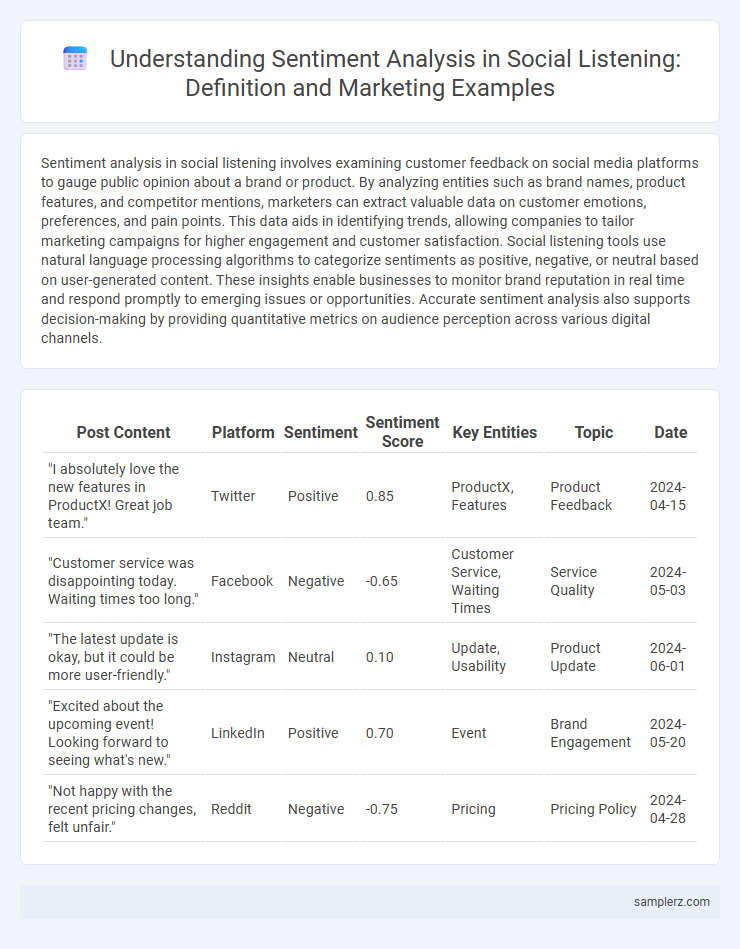Sentiment analysis in social listening involves examining customer feedback on social media platforms to gauge public opinion about a brand or product. By analyzing entities such as brand names, product features, and competitor mentions, marketers can extract valuable data on customer emotions, preferences, and pain points. This data aids in identifying trends, allowing companies to tailor marketing campaigns for higher engagement and customer satisfaction. Social listening tools use natural language processing algorithms to categorize sentiments as positive, negative, or neutral based on user-generated content. These insights enable businesses to monitor brand reputation in real time and respond promptly to emerging issues or opportunities. Accurate sentiment analysis also supports decision-making by providing quantitative metrics on audience perception across various digital channels.
Table of Comparison
| Post Content | Platform | Sentiment | Sentiment Score | Key Entities | Topic | Date |
|---|---|---|---|---|---|---|
| "I absolutely love the new features in ProductX! Great job team." | Positive | 0.85 | ProductX, Features | Product Feedback | 2024-04-15 | |
| "Customer service was disappointing today. Waiting times too long." | Negative | -0.65 | Customer Service, Waiting Times | Service Quality | 2024-05-03 | |
| "The latest update is okay, but it could be more user-friendly." | Neutral | 0.10 | Update, Usability | Product Update | 2024-06-01 | |
| "Excited about the upcoming event! Looking forward to seeing what's new." | Positive | 0.70 | Event | Brand Engagement | 2024-05-20 | |
| "Not happy with the recent pricing changes, felt unfair." | Negative | -0.75 | Pricing | Pricing Policy | 2024-04-28 |
Understanding Sentiment Analysis in Social Listening
Sentiment analysis in social listening enables brands to detect customer emotions across social media platforms by analyzing keywords, hashtags, and user comments. This technique helps marketers identify positive, negative, or neutral sentiments, allowing real-time adjustments to campaigns based on audience feedback. Tools like Brandwatch and Sprout Social provide detailed sentiment reports that drive data-informed decisions and enhance customer engagement strategies.
The Role of Sentiment Analysis in Modern Marketing
Sentiment analysis in social listening enables marketers to gauge consumer emotions across social media platforms, providing real-time insights into brand perception and customer satisfaction. By analyzing vast amounts of user-generated content, sentiment analysis helps identify emerging trends, potential crises, and opportunities for targeted campaigns. This data-driven approach enhances decision-making, supports personalized marketing strategies, and drives improved customer engagement in competitive markets.
Real-World Examples of Sentiment Analysis Applications
Sentiment analysis in social listening enables brands like Nike to monitor consumer reactions during product launches, capturing positive, negative, and neutral opinions to adjust marketing strategies in real time. Coca-Cola uses sentiment analysis to gauge public response to advertising campaigns, identifying emotional triggers that drive engagement on platforms like Twitter and Instagram. By analyzing customer feedback on Amazon reviews, companies can detect trends in satisfaction and pain points, enhancing product development and overall customer experience.
How Brands Leverage Sentiment Analysis for Product Feedback
Brands leverage sentiment analysis in social listening to gather real-time consumer emotions and opinions, enabling precise product feedback evaluation. By analyzing social media mentions, reviews, and comments, companies identify positive, negative, and neutral sentiments to detect trends and areas for product improvement. This data-driven approach helps optimize product development, enhance customer satisfaction, and tailor marketing strategies effectively.
Sentiment Analysis in Crisis Management
Sentiment analysis in crisis management enables brands to quickly detect negative customer emotions and urgent complaints across social media platforms, allowing rapid response to mitigate damage. By analyzing real-time sentiment trends, marketers can identify escalating issues and adjust communication strategies to restore brand trust effectively. This proactive approach minimizes reputation risks and enhances overall crisis resolution efficiency.
Case Study: Competitor Benchmarking via Social Listening
Sentiment analysis in social listening enables brands to gauge competitor performance by analyzing consumer opinions across platforms like Twitter, Facebook, and Instagram. For example, a case study examining sentiment trends revealed that Brand A consistently received 30% more positive mentions than Brand B during product launches, highlighting stronger customer satisfaction and loyalty. This data-driven insight allows marketers to tailor strategies, enhance brand positioning, and capitalize on competitor weaknesses.
Improving Customer Experience Through Sentiment Insights
Sentiment analysis in social listening enables brands to decode customer emotions from online conversations, allowing real-time identification of pain points and positive feedback. By leveraging AI-driven sentiment insights, marketers tailor personalized experiences that increase engagement and loyalty. This data-driven approach transforms unstructured social data into actionable strategies, significantly enhancing overall customer satisfaction.
Monitoring Brand Reputation with Sentiment Analysis
Sentiment analysis in social listening enables brands to monitor customer opinions and emotions across social media platforms, providing real-time insights into their brand reputation. Tools like Brandwatch and Sprout Social analyze positive, negative, and neutral sentiments, helping marketers identify potential crises or emerging trends swiftly. This proactive approach allows companies to manage public perception effectively and tailor marketing strategies to enhance brand loyalty.
Influencer Marketing Optimization Using Sentiment Data
Sentiment analysis in social listening enables brands to gauge public opinion about influencers by categorizing positive, neutral, and negative mentions across social media platforms. Marketers leverage this data to identify high-performing influencers whose audience sentiment aligns with brand values, optimizing partnership decisions. Campaign adjustments based on sentiment trends improve engagement rates and enhance overall influencer marketing ROI.
Sentiment Analysis Tools: Top Choices for Marketers
Sentiment analysis tools like Brandwatch, Talkwalker, and Sprout Social enable marketers to gauge consumer emotions by analyzing social media conversations and reviews in real time. These platforms leverage natural language processing (NLP) and machine learning algorithms to categorize sentiments as positive, negative, or neutral, providing actionable insights for brand reputation management and campaign optimization. Leading sentiment analysis tools integrate advanced analytics dashboards, customizable filters, and multilingual support, enhancing marketers' ability to monitor brand perception globally and respond promptly to emerging trends.

example of sentiment analysis in social listening Infographic
 samplerz.com
samplerz.com